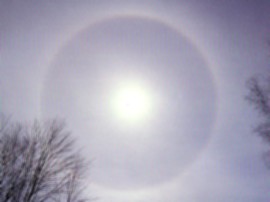
THE AIRLINE PILOTS FORUM & RESOURCE
Haloes |
| Source: Excerpt from The Book " Weather " |
 |

A halo is a white or faintly colored ring that sometimes appears around the Sun or (less often) the Moon. Whereas coronas almost appear to emanate from these light sources, haloes form a thin, wide circle around them. The main difference between the two phenomena is that coronas require water droplets to form, while haloes require ice crystals. These crystals may be free-falling or within thin layers of cirrus cloud. Normally, when sun-light or moonlight strikes ice crystals, most of the light is reflected, producing a completely white halo. However, if the incoming light strikes the falling ice crystals at a particular angle, some light may be refracted. In such a case, the halo will be faintly colored, with red appearing nearest the center and blue on the outside. This is the reverse order of the corona's colors, because of the difference between light refraction and diffraction. Most ice crystals are hexagonal, or six-sided, and the most common angle of refraction through such a crystal is about 22 degrees. The most common haloes are those produced in this way, and are known as 22 degree haloes. Differently shaped crystals, or those at a different angle to the Sun, may produce haloes of various sizes and shapes. Smaller haloes at 9 degrees and larger ones at 46 degrees are not uncommon, and sometimes a halo will only partially form, appearing as an arc. In folkore, haloes have long been associated with approaching rain, and there is a grain of truth in this. The cirrus cloud that can produce a halo may well indicate an approaching frontal system. However, in many cases, this front will be inactive, or may veer away from the area, producing no rain. As a result, the forecasting value of haloes is limited. |
Acknowledgement: John W. Zillman, William J. Burroughs,
Bob Crowder, Ted Robertson, Eleanor Vallier-Talbot and Richard Whitaker.
